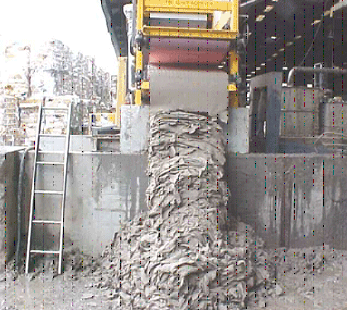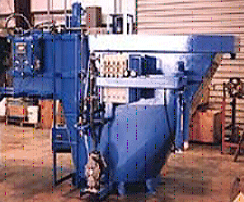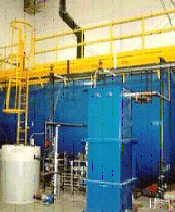Sludge conditioning is a process whereby sludge solids are treated with chemicals or various other means to prepare the sludge for dewatering processes
Chemical Conditioning: Chemical conditioning (sludge conditioning) prepares the sludge for better and more economical treatment with vacuum filters or centrifuges. Many chemicals have been used such as sulfuric acid, alum, chlorinated copperas, ferrous sulfate, and ferric chloride with or without lime, and others.
 The local cost of the various chemicals is usually the determining factor. In recent years the price of ferric chloride has been reduced to a point where it is the one most commonly used.
The local cost of the various chemicals is usually the determining factor. In recent years the price of ferric chloride has been reduced to a point where it is the one most commonly used.
The addition of the chemical to the sludge lowers or raises its pH value to a point where small particles coagulate into larger ones and the water in the sludge solids is given up most readily. There is no one pH value best for all sludges. Different sludges such as primary, various secondary and digested sludge and different sludges of the same type have different optimum pH values which must be determined for each sludge by trial and error. Tanks for dissolving acid salts, such as ferric chloride, are lined with rubber or other acid-proof material. Intimate mixing of sludge and coagulant is essential for proper conditioning. Feeders are also necessary for applying the chemicals needed for proper chemical conditioning.
The most frequently encountered conditioning practice is the use of ferric chloride either alone or in combination with lime. The use of polymers is rapidly gaining widespread acceptance. Although ferric chloride and lime are normally used in combination, it is not unusual for them to be applied individually. Lime alone is a fairly popular conditioner for raw primary sludge and ferric chloride alone has been used for conditioning activated sludges. Lime treatment to a pH of 10.4 or above has the added advantage of providing a significant degree (over 99 percent) of disinfection of the sludge.
Organic polymer coagulants, and coagulant aids have been developed in the past 20 years and are rapidly gaining acceptance for sludge conditioning. These polymers are of three basic types:
Anionic (negative charge) – serve as coagulants aids to inorganic Aluminum and Iron coagulants by increasing the rate of flocculation, size, and toughness of particles.
Cationic (positive charge) – serve as primary coagulants alone or in combination with inorganic coagulants such as aluminum sulfate.
Nonionic (equal amounts of positively and negatively charged groups in monomers) – serve as coagulant aids in a manner similar to that of both anionic and cationic polymers.The popularity of polymers is primarily due to their ease in handling, small storage space requirements, and their effectiveness. All of the inorganic coagulants are difficult to handle and their corrosive nature can cause maintenance problems in the storing, handling, and feeding systems in addition to the safety hazards inherent in their handling.
 Thermal Conditioning : There are two basic processes for thermal treatment of sludges. One, wet air oxidation, is the flameless oxidation of sludges at temperatures of 450 to 550°F and pressures of about 1200 psig. The other type, heat treatment, is similar but carried out at temperatures of 350 to 400°F and pressures of 150 to 300 psig. Wet air oxidation reduces the sludge to an ash and heat treatment improves the dewaterability of the sludge. The lower temperature and pressure heat treatment is more widely used than the oxidation process.When the organic sludge is heated, heat causes water to escape from the sludge. Thermal treatment systems release water that is bound within the cell structure of the sludge and thereby improves the dewatering and thickening characteristics of the sludge. The oxidation process further reduces the sludge to ask by wet incineration (oxidation). Sludge is ground to a controlled particle size and pumped to a pressure of about 300 psi. Compressed air is added to the sludge (wet air oxidation only), the mixture is brought to a temperature of about 350°F by heat exchange with treated sludge and direct steam injection, and then is processed (cooked) in the reactor at the desired temperature and pressure. The hot treated sludge is cooled by heat exchange with the incoming sludge. The treated sludge is settled from the supernatant before the dewatering step. Gases released at the separation step are passed through a catalytic after-burner at 650 to 705°F or deodorized by other means. In some cases these gases have been returned through the diffused air system in the aeration basins for deodorization.An advantage of thermal treatment is that a more readily dewaterable sludge is produced than with chemical conditioning. Dewatered sludge solids of 30 to 40 percent (as opposed to 15 to 20 percent with chemical conditioning) have been achieved with heat treated sludge at relatively high loading rates on the dewatering equipment (2 to 3 times the rates with chemical conditioning). The process also provides effective disinfection of the sludge.Unfortunately, the heat treatment process ruptures the cell walls of biological organisms, releasing not only the water but some bound organic material. This returns to solution some organic material previously converted to particulate form and creates other fine particulate matter. The breakdown of the biological cells as a result of heat treatment converts these previously particulate cells back to water and fine solids. This aids the dewatering process, but creates a separate problem of treating this highly polluted liquid from the cells. Treatment of this water or liquor requires careful consideration in design of the plant because the organic content of the liquor can be extremely high.
Thermal Conditioning : There are two basic processes for thermal treatment of sludges. One, wet air oxidation, is the flameless oxidation of sludges at temperatures of 450 to 550°F and pressures of about 1200 psig. The other type, heat treatment, is similar but carried out at temperatures of 350 to 400°F and pressures of 150 to 300 psig. Wet air oxidation reduces the sludge to an ash and heat treatment improves the dewaterability of the sludge. The lower temperature and pressure heat treatment is more widely used than the oxidation process.When the organic sludge is heated, heat causes water to escape from the sludge. Thermal treatment systems release water that is bound within the cell structure of the sludge and thereby improves the dewatering and thickening characteristics of the sludge. The oxidation process further reduces the sludge to ask by wet incineration (oxidation). Sludge is ground to a controlled particle size and pumped to a pressure of about 300 psi. Compressed air is added to the sludge (wet air oxidation only), the mixture is brought to a temperature of about 350°F by heat exchange with treated sludge and direct steam injection, and then is processed (cooked) in the reactor at the desired temperature and pressure. The hot treated sludge is cooled by heat exchange with the incoming sludge. The treated sludge is settled from the supernatant before the dewatering step. Gases released at the separation step are passed through a catalytic after-burner at 650 to 705°F or deodorized by other means. In some cases these gases have been returned through the diffused air system in the aeration basins for deodorization.An advantage of thermal treatment is that a more readily dewaterable sludge is produced than with chemical conditioning. Dewatered sludge solids of 30 to 40 percent (as opposed to 15 to 20 percent with chemical conditioning) have been achieved with heat treated sludge at relatively high loading rates on the dewatering equipment (2 to 3 times the rates with chemical conditioning). The process also provides effective disinfection of the sludge.Unfortunately, the heat treatment process ruptures the cell walls of biological organisms, releasing not only the water but some bound organic material. This returns to solution some organic material previously converted to particulate form and creates other fine particulate matter. The breakdown of the biological cells as a result of heat treatment converts these previously particulate cells back to water and fine solids. This aids the dewatering process, but creates a separate problem of treating this highly polluted liquid from the cells. Treatment of this water or liquor requires careful consideration in design of the plant because the organic content of the liquor can be extremely high.
 Blending is a process where two or more types of sludges are “blended” together to facilitate a higher sludge solids concentration and a more homogenous mixture of sludge prior to dewatering. Blending operations tends to decrease the chemical demand for conditioning and dewatering sludges.The blending operation usually takes place in sludge holding tanks normally where primary sludge is mixed with waste activated sludge. The amounts of the sludges to be blended can only be found by experimentation, with the final results being seen at the dewatering operations.
Blending is a process where two or more types of sludges are “blended” together to facilitate a higher sludge solids concentration and a more homogenous mixture of sludge prior to dewatering. Blending operations tends to decrease the chemical demand for conditioning and dewatering sludges.The blending operation usually takes place in sludge holding tanks normally where primary sludge is mixed with waste activated sludge. The amounts of the sludges to be blended can only be found by experimentation, with the final results being seen at the dewatering operations.

